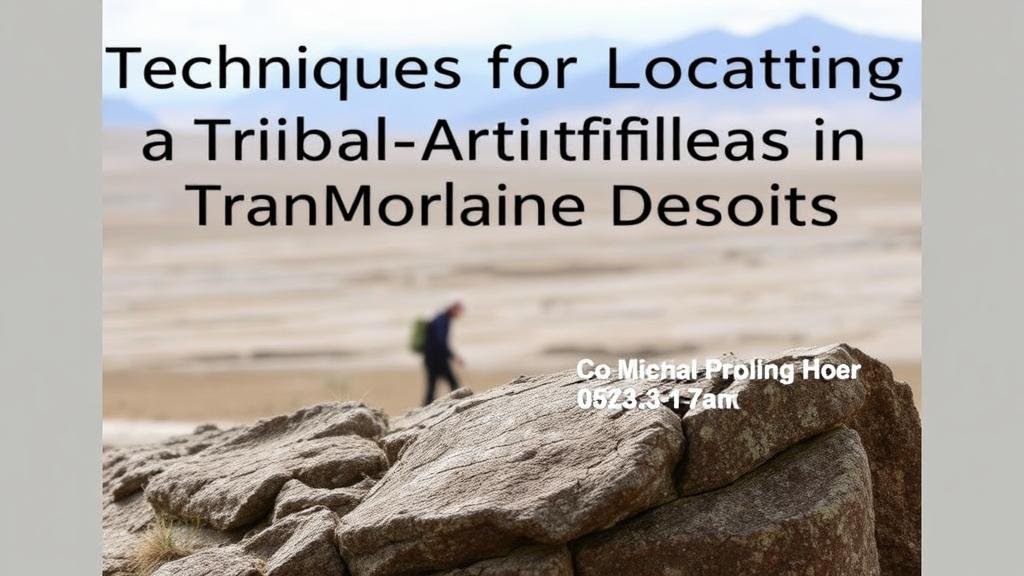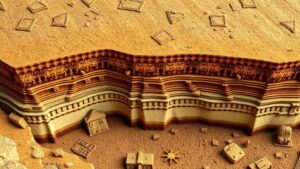Techniques for Locating Tribal Artifacts in Glacial Moraine Deposits
Techniques for Locating Tribal Artifacts in Glacial Moraine Deposits
The identification and excavation of tribal artifacts in glacial moraine deposits represent a significant intersection of archaeology, geology, and anthropology. Glacial moraines, formed from the accumulation of debris such as rocks, soil, and organic materials pushed along by glaciers, can serve as rich repositories for historical artifacts. This article will delve into various techniques employed by archaeologists and researchers to locate tribal artifacts within these unique geological setups, emphasizing practical approaches, challenges, and the integration of modern technology.
Understanding Glacial Moraine Deposits
Before discussing the techniques for locating artifacts, it is essential to comprehend the characteristics of glacial moraine deposits. e deposits are formed from the material that glaciers transport and deposit as they advance and retreat. The composition of moraine can vary greatly, including:
- Till: Unsorted sediment dropped directly by glacial ice.
- Outwash: Sorted sediment carried away from the glacier by meltwater.
- Ground Moraine: A blanket of till deposited under the glacier.
This variability not only defines the physical landscape but also suggests potential locations for artifact development. Artifacts can become embedded in these deposits, offering insights into the environmental context of historical human activity.
Field Survey Techniques
The first step in locating tribal artifacts is conducting field surveys. Archaeologists utilize several methods to systematically search for artifacts within moraine deposits:
- Visual Inspection: This method involves walking across the landscape and observing surface artifacts. It is particularly effective in areas where erosion has exposed items on the surface.
- Systematic Excavation: Focused digging in specific areas based on hypotheses about where artifacts may have been deposited, such as near water sources or historically significant sites.
For example, in the 2010 excavation in the northern Great Lakes region, archaeologists discovered an extensive array of stone tools and pottery remnants in glacial moraine deposits adjacent to ancient waterways, illustrating the importance of terrain analysis in guiding excavation strategies.
Geophysical Survey Methods
Advancements in technology have significantly enhanced the ability to locate artifacts without extensive physical disruption of the site. Geophysical survey methods include:
- Ground Penetrating Radar (GPR): A non-invasive tool that uses radar pulses to image the subsurface. Researchers have effectively used GPR to identify sub-surface features indicating potential artifact locations without excavation.
- Magnetometry: This technique measures the magnetic field of buried artifacts, allowing archaeologists to detect ferromagnetic materials or changes in magnetic signatures associated with human activity.
In a notable case study in Wisconsin, a GPR survey revealed several potential burial sites beneath glacial moraine, which were later excavated to uncover artifacts from local indigenous tribes, demonstrating the efficacy of these technologies.
Soil Analysis Techniques
Soil analysis is another critical technique in locating artifacts. By studying the composition of soil samples taken from glacial moraine deposits, researchers can identify areas that might have housed human activity. Important methodologies include:
- Soil Stratigraphy: Analyzing the layers of soil can provide insights into historical occupation periods, helping to identify the stratified layers in which artifacts may be found.
- Paleobotany: Examining plant remains within soil samples can offer rich contextual data about the landscape during different periods, guiding excavations toward areas likely to yield artifacts.
For example, in an investigation of moraine in the Adirondack Mountains, soil stratigraphy revealed multiple layers indicating significant human occupation over millennia, resulting in successful artifact recovery initiatives.
Collaboration With Indigenous Communities
Engaging with indigenous communities substantially enriches the process of locating tribal artifacts. Local knowledge profoundly impacts the understanding of historical contexts and locations of significance. Collaborative techniques can involve:
- Community Involvement: Working with community members who have ancestral ties to the area can help identify likely locations based on oral histories and traditional ecological knowledge.
- Participatory Research: Incorporating indigenous methodologies in research design can yield more accurate representations of historical significance and artifact preservation practices.
An excellent example of this collaboration occurred with Tribal Nations in Canada, where local indigenous groups played an integral role in identifying the locations of historical artifact sites, leading to discoveries previously overlooked by traditional methods.
Conclusion and Actionable Takeaways
The search for tribal artifacts within glacial moraine deposits requires an amalgamation of traditional archaeological techniques and modern technologies, complemented by the involvement of indigenous communities. Here are some actionable takeaways for those interested in this research area:
- Engage in interdisciplinary approaches that include geology, archaeology, and local cultural knowledge.
- Use technology like GPR and magnetometry to minimize site disturbance while maximizing artifact discovery.
- Prioritize collaboration with indigenous communities to ensure respectful and culturally informed research methodologies.
By implementing these techniques, researchers can enhance the integrity of their work while making significant contributions to the understanding of human history embedded in glacial landscapes.



